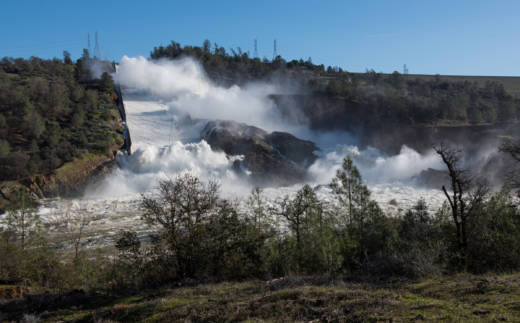The Associated Press contributed reporting to this story.
Update: Sunday, Feb. 12, 10:45 p.m.: The level of Lake Oroville has dropped enough to prevent water from cascading over the emergency spillway, stopping the erosion that threatens the structure, water officials said late Sunday.
Butte County Sheriff Kory Honea said this doesn’t mean the area is out of danger, however, and he doesn’t yet know when he might have enough information to lift the evacuation order.
“We need to give the Department of Water Resources (DWR) time to thoroughly evaluate [the spillway], in order to make decisions about whether or not it is safe to repopulate areas,” Honea said. “I recognize how tough this situation is on people, but as you’ve heard tonight, we needed to do that to ensure the public safety. And that’s the thing we’ll focus on going forth.”
Gov. Jerry Brown issued an emergency proclamation late Sunday, freeing up personnel and equipment to help with everything from evacuations to flood control to patrolling evacuated areas. The California Highway Patrol, Cal Fire and the National Guard have deployed helicopters, planes, fire engines and high water trucks — or have them standing by — and have mobilized hundreds of law enforcement and other personnel, including swift water rescue teams.
DWR on Sunday nearly doubled the flow over the primary concrete spillway, from 55,000 to 100,000 cubic feet per second. That brought the level of the lake down below the lip of the emergency spillway by mid-evening, easing the threat of collapse. But water officials now want to lower the lake another 50 feet, to make room for storms due later this week.
The agency’s acting director, Bill Croyle, said officials were able to get up in helicopters to inspect the spillway visually Sunday night, but need to be out on the ground tomorrow at first light to look at the erosion scar. Croyle said the goal is to ensure the emergency spillway not only doesn’t fail, but is able to be used the rest of the winter rainy season, if necessary.
“This erosion scar happened for a reason, so we want to understand that,” Croyle said, adding that the department has not yet dropped any bags of rocks into the erosion scar, or taken any other corrective measures to repair it
Officials said evacuation orders affect 76,000 residents in Yuba City, 65,000 in Yuba County, 35,000 in Butte County and 12,000 people in Marysville. The California Highway Patrol is urging evacuees to take Highway 99 or State Route 70 north to escape the area.
Original Story, Sunday Feb. 12:
State water officials say the “auxiliary” spillway at Oroville Dam could fail at any time and they ordered emergency evacuations late this afternoon for thousands of people from Oroville to Gridley.
“We didn’t have the luxury of waiting to see if all was OK,” said Butte County Sheriff Kory Honea, explaining that when he ordered the evacuations, officials believed the spillway might collapse within hours. “We needed to get people moving and save lives in case the worst-case scenario came to fruition.”
The California Department of Water Resources urged residents of Oroville to head north, toward Chico. Residents elsewhere downstream should follow the orders of their local law enforcement, the department said. Officials have set up an evacuation shelter at the Silver Dollar Fairgrounds in Chico.
The spillway is still holding, despite a hole that is eroding at its lower edge, due to the pressure of water cascading over the lip of the spillway. Earlier Sunday, water officials estimated the hole was eroding inward at a fast enough rate to cause a collapse sometime in the early evening, but at a press conference shortly after 6 p.m., officials said the hole was eroding more slowly than they’d expected.
Sheriff Hornea said the plan is to use helicopters to drop bags of rocks into the crevice and prevent further erosion. Cal Fire incident commander Kevin Lawson said the agency has helicopters and engines standing ready to be deployed and is mobilizing hand crews on both sides of the river to assist with any flooding.
Water officials said they are relieving pressure on the spillway by increasing water flows down the primary concrete spillway, and that they have not seen any further damage Sunday to the concrete, due to the additional water. The primary spillway developed a massive cavity last week, which has expanded as water flows increased.
The auxiliary spillway is separate from the main dam structure. It’s essentially an ungated 1,700-foot-wide notch in the rim of the reservoir, which began overflowing Saturday morning, days after the dam’s concrete-lined main spillway began to crumble. Below an initial concrete lip, water courses over bare earth all the way to the Feather River below, scouring the incline of earth, rocks and trees.












